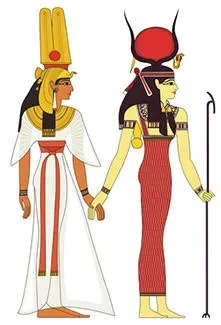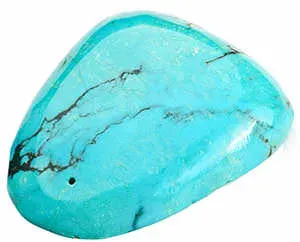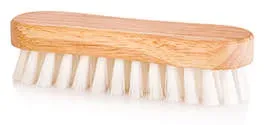 Turquoise is the birthstone for the month of December and the gift given in celebration of the fifth and eleventh wedding anniversaries. Since the days of the ancient Egyptians, turquoise has been known throughout the world and has been in great demand. Turquoise was one of the first gemstones ever mined, perhaps dating back to 6000 BC, in Egypt's Sinai Peninsula. The name turquoise comes from the same French word, Turquoise, meaning Turkish, since it originally arrived in Europe through Turkey, originating in Iran. Turquoise has been mined in Iran for over 3,000 years. It has been used for thousands of years for jewelry by the Ancient Egyptians, who buried fine pieces with mummies. Aztecs fashioned elaborate turquoise masks. Today, Native Americans, especially the Zuni and Navajo peoples, produce the most renowned pieces in the US, such as turquoise and silver bracelets, necklaces, rings, earrings, pendants, brooches, and belt buckles. In the past, the stone was also used as beads in cameos, and irregular pieces were used for mosaics.
Turquoise is the birthstone for the month of December and the gift given in celebration of the fifth and eleventh wedding anniversaries. Since the days of the ancient Egyptians, turquoise has been known throughout the world and has been in great demand. Turquoise was one of the first gemstones ever mined, perhaps dating back to 6000 BC, in Egypt's Sinai Peninsula. The name turquoise comes from the same French word, Turquoise, meaning Turkish, since it originally arrived in Europe through Turkey, originating in Iran. Turquoise has been mined in Iran for over 3,000 years. It has been used for thousands of years for jewelry by the Ancient Egyptians, who buried fine pieces with mummies. Aztecs fashioned elaborate turquoise masks. Today, Native Americans, especially the Zuni and Navajo peoples, produce the most renowned pieces in the US, such as turquoise and silver bracelets, necklaces, rings, earrings, pendants, brooches, and belt buckles. In the past, the stone was also used as beads in cameos, and irregular pieces were used for mosaics.
 Turquoise is a hydrated phosphate of copper and aluminum. The stone has been long prized for its intense color, which varies from sky blue to a paler sky blue, to greenish blue, or pale green, depending on the quantities of iron and copper within it. Like other gems, the richer color types are the most appreciated. The most preferred color is a strong sky blue. Pale greenish blue is less highly prized and the pale green variety even less so. Turquoise's intense blue color is often modeled with veins of brown limonite or black manganese oxide. Turquoise with black veins is called "Spider web" turquoise. Turquoise rates a 5-6 on the hardness scale.
Turquoise is a hydrated phosphate of copper and aluminum. The stone has been long prized for its intense color, which varies from sky blue to a paler sky blue, to greenish blue, or pale green, depending on the quantities of iron and copper within it. Like other gems, the richer color types are the most appreciated. The most preferred color is a strong sky blue. Pale greenish blue is less highly prized and the pale green variety even less so. Turquoise's intense blue color is often modeled with veins of brown limonite or black manganese oxide. Turquoise with black veins is called "Spider web" turquoise. Turquoise rates a 5-6 on the hardness scale.
 Laboratory-made turquoise has uniform color and no veins. The best quality turquoise still comes from Iran but in relative small quantities. Turquoise occurs in a green variety in Tibet. It is also found in various colors in the Mojave Desert of California, the Cerrillos Hills near Santa Fe, New Mexico, Arizona, Nevada, Utah and Colorado. Many of these deposits were mined centuries ago by Native Americans. Additional mines are in England, Australia, Siberia, France, Germany, Chile, Egypt, Tibet, Mexico and China. There have been many beliefs in the virtues of turquoise by many different people throughout time, and throughout the world. The Zuni people of New Mexico have created striking turquoise jewelry, believing these pieces protect them from demons. The Navajos believe the blue stones are magical pieces that fall from the sky. Apache warriors wore turquoise in the belief that it improved their hunting prowess. The stone's color change was also once thought to indicate danger or illness.
Laboratory-made turquoise has uniform color and no veins. The best quality turquoise still comes from Iran but in relative small quantities. Turquoise occurs in a green variety in Tibet. It is also found in various colors in the Mojave Desert of California, the Cerrillos Hills near Santa Fe, New Mexico, Arizona, Nevada, Utah and Colorado. Many of these deposits were mined centuries ago by Native Americans. Additional mines are in England, Australia, Siberia, France, Germany, Chile, Egypt, Tibet, Mexico and China. There have been many beliefs in the virtues of turquoise by many different people throughout time, and throughout the world. The Zuni people of New Mexico have created striking turquoise jewelry, believing these pieces protect them from demons. The Navajos believe the blue stones are magical pieces that fall from the sky. Apache warriors wore turquoise in the belief that it improved their hunting prowess. The stone's color change was also once thought to indicate danger or illness.
 The best way to clean turquoise is with warm, sudsy water and a soft brush. It is important to dry it immediately with a cloth. Avoid any exposure to sharp blows, scratches, chemicals, sunlight or any high heat, dry air and grease. Do not use commercial jewelry cleansers. Some porous specimens, especially in the US, may require an impregnation with resin or wax in order to resist fading and cracking.
The best way to clean turquoise is with warm, sudsy water and a soft brush. It is important to dry it immediately with a cloth. Avoid any exposure to sharp blows, scratches, chemicals, sunlight or any high heat, dry air and grease. Do not use commercial jewelry cleansers. Some porous specimens, especially in the US, may require an impregnation with resin or wax in order to resist fading and cracking.